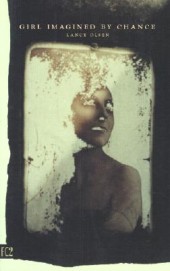 Lance Olsen
Lance Olsen
FC2 ($13.95)
by Rochelle Ratner
Far too little literature has focused on couples who consciously elect to remain childless. Until the 1990s, the subject was basically taboo, in conversation as well as the printed word. Or, especially when a male writer approached the subject, as Edward Albee did in Who's Afraid of Virginia Woolf and the more recent The Play About the Baby, we are introduced to characters that might best be described as dysfunctional, with a power-play at the center of the drama.
The couple portrayed in Girl Imagined by Chance is precisely the opposite, so anxious to please each other, taking such delight in the time they spend together, that readers might well wish their own marriages were equally stable. That caring applies to the extended family as well, particularly between Andi and her grandmother. Now, at age 89, what Grannam wants most in life is a great-grandchild. What Grannam doesn't know is that not only does Andi (which also happens to be the name of Olsen's wife) not want children, but she's gone through surgery to be sure pregnancy doesn't happen by accident. So when Andi and her husband, the novel's narrator, move to Idaho, about as far away from New Jersey as they can get, they see no harm in telling the old woman she's pregnant. And before long are telling other friends back east as well.
The moment Andi announces she's pregnant, Grannam sends a check. Then another check. The couple decides to start a college fund, and in return, they send pictures of the sonogram (downloaded from a website). Looking further on the web, they learn what is to be expected during pregnancy, and Andi develops her own variations on cravings, cramps and nausea. They shop for baby furniture. They drive to the hospital in the middle of the night when Andi goes into labor. They send pictures of the baby (baby pictures of Andi, put through various photo programs, and of course Grannam remarks on the strong likeness). They drive to the mall and study how toddlers think and act, so they can give accurate reports. Not only do they plan a visit with the baby, they actually purchase plane tickets.
At its most simplistic level, Girl Imagined by Chance is a fast-paced, hysterical sitcom for thinking readers. Especially during the first half of the book (or before things really get out of hand), I found myself laughing out loud. Particularly memorable is the couple's conversation while at a suburban movie theater, watching "a lightweight spoof about the wacky adorable things kids do":
I don't want something forming inside me that literally makes me sick day after day. Sciatica. Vomiting. The unstoppable need to urinate.
She helped herself to a handful of your popcorn.
Constipation, she added. Varicose veins.
The young couple behind you shushed you.
Andi turned in her seat and shushed them back.
This conversation goes on for nearly three pages; the couple behind them finally moves their seat, and Andi realizes the woman's pregnant.
Olsen is a master at incorporating everyday mundanities into his narrative. We see his characters chopping wood, painting the house, shopping and cooking, all of which adds to the book's grounding in reality, creating an atmosphere of familiarity that encourages readers to join in the fun. A more traditional writer would probably end here, and the resulting novel would be not only enjoyable, it could be made into a film.
But Olsen is anything but traditional, and here is where his intelligence—not to mention his rooting in cyberpunk, metafiction, and the like—comes into play. This is, as much as anything else, a book about the image of reality. An epigraph proudly quotes a Minolta ad: "It's hard to tell where you leave off and the camera begins." We see him doctoring photos (there are photos prefacing the chapters), and Andi is a photographer. He tosses in reflective and theoretical comments by Diane Arbus, Ansel Adams, Roland Barthes, Eadweard Muybridge, and others. He encapsulates the history of photography. He repeats himself. Even Andi's selection of the name "Genia" for their daughter has its roots in philosophy. "As in phototogenic? you ask?" Then the next day the conversation continues:
Your body teaches you a little more every day.
There's a small genie in it, too, you point out after a while.
And, says Andi, the tiniest hint of genesis.
Huh, you say. Sure. And genes, too, of course. Don't forget genes. Nothing overstated, mind you, nothing overdone.
Eventually, language and concept take over, temporarily blotting out Genia's antics and the efforts of her stressed-out parents to control her. Here some readers may find themselves unnerved that the book has shifted gears, as many demand a continuous plot no matter how fascinating the language. But the beauty of this book is that, despite a place in the middle where the need to create and then destroy this baby bogs down, it works on both levels. And then some.
Click here to purchase this book at your local independent bookstore

Click here to buy this book at Amazon.com
Rain Taxi Online Edition, Fall 2002 | © Rain Taxi, Inc. 2002
